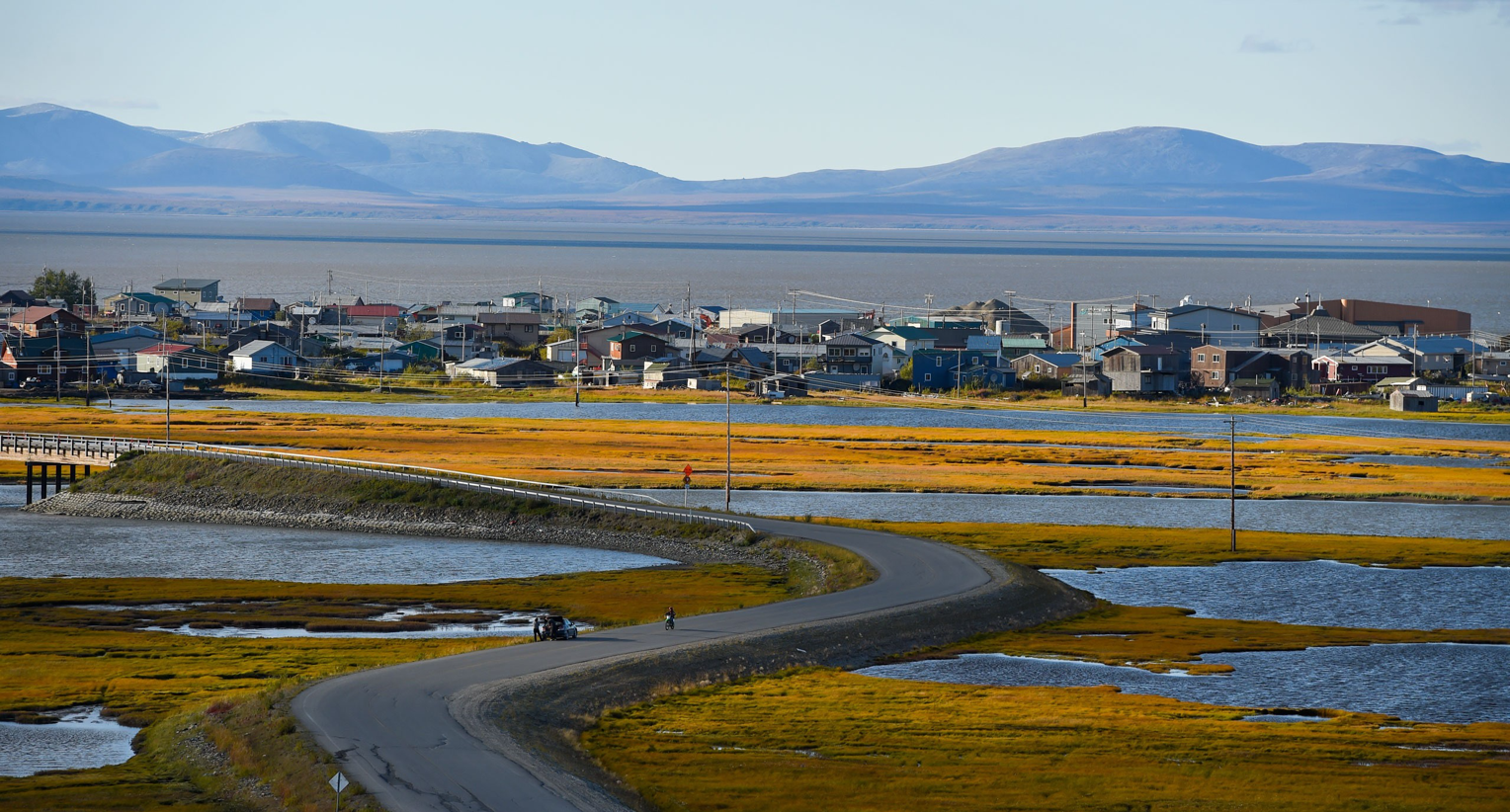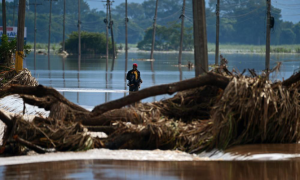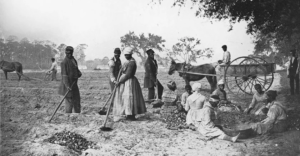Reid Magdanz got the call on December 21st. He was sitting at home, in his little red house, in the town of Kotzebue, on the western coast of Alaska. It was the winter solstice, the shortest day of the year. The sun had risen around 1 P.M., but by the time Magdanz’s phone rang, an hour later, the sun had already begun to sink back toward the horizon. He answered the call, and, as soon as he was off the line, grabbed his handmade beaver hat and headed out the door.
Magdanz was born and raised in Kotzebue. The town has some thirty-five hundred residents, roughly seventy per cent of whom are Iñupiat. (Magdanz, who is thirty years old, and white, rotates between working construction jobs in the summer and working on Iñupiaq language-revitalization projects in the winter.) Kotzebue is thirty-three miles north of the Arctic Circle, which means that sunlight is fleeting, even on non-solstice days. In the weak winter sun, shadows disappear, and everything looks flat. On the afternoon of the twenty-first, it was windy and below ten degrees Fahrenheit, but Magdanz didn’t feel too cold. He walked two blocks to the local hospital and entered a heated tent that had been set up outside. He said hello to a few people he recognized: some guys from the local freight and fuel companies. There was no line. It was over within twenty minutes. The walk home was against the wind, and a little colder. He was back at work by 2:30 P.M. “You feel kind of lucky,” Magdanz said, “to have the opportunity to get the vaccine.”
Towns across rural Alaska are beating the rest of the country in vaccine distribution. In Manhattan, about seven per cent of the population has been fully vaccinated, and in L.A. County, the number is just under ten per cent. These states have been plagued by rollout mismanagement, overloaded Web sites, and supply-chain problems: providers in New York have reported throwing away unused doses, and San Diego health officials have resorted to tweeting about available appointments that need to be filled. Alaska, meanwhile, has given the first shot to nearly eighteen per cent of its population—a higher percentage than any other state in the nation. In Sitka, the small Alaskan town where I live, fifteen hundred people—out of a total population of eight thousand—have already received second doses. We’re on track to complete vaccinations this spring. In many rural towns throughout the state, it is the tribal health organizations, not the state government, that are in charge of vaccine distribution.
Alaska has one of the lowest death rates from COVID-19 in the country. The fatalities, however, have followed a dark historical pattern. In 1900, influenza and measles decimated the western part of the state, with Native communities losing as much as fifty per cent of their population; two decades later, when the Spanish flu hit, Alaska Natives accounted for forty-eight per cent of the state’s population and more than eighty per cent of deaths. A century later, Alaska Native people account for almost forty per cent of COVID-19 deaths—while only comprising sixteen per cent of the population. The death rate is nearly double that of other ethnic groups.
It is difficult to overstate the level of isolation of these communities, which at various points, have had some of the highest COVID-19 case rates in the country. To get to Akutan, an Unangax town of a hundred people along the Aleutian Island chain, residents must fly to a neighboring island and then take a helicopter seven miles west. In Teller, a two-hundred-person Iñupiaq town located on a Bering Sea spit north of Nome, residents rely on hunting and fishing to supplement their food supply. The Alutiiq village of Port Lions, located on the northern part of Kodiak Island, has no grocery store—instead, residents can order staples such as flour and sugar, which are delivered by plane. In many communities, the nearest hospitals are often hundreds of miles and a flight away.
THE DAILY
The best of The New Yorker, every day, in your in-box.
Tribes are sovereign nations and therefore set their own allocation of vaccines and distribution priorities. In December, once the vaccines arrived, tribal nations were among the first to vaccinate elders who were sixty-five and older (despite federal guidelines suggesting age cut-offs at seventy-five). The state of Alaska soon followed suit, and shortly after, so did the rest of the country. Many tribal health organizations also chose to vaccinate both Native and non-Native populations, some prioritizing those who live in Native households or work in essential services. Though they coöperate with their local communities, tribal health organizations each have their own guidelines and autonomy over whom they choose to vaccinate. In Unalaska, for example, the Qawalangin tribe chose to prioritize teachers and school staff, and began vaccinating them in January. The state just opened up vaccines to teachers last week.
Big cities like Anchorage and Juneau, which are serviced mainly by the Alaskan state government, have been plagued by rollout issues similar to those in the Lower Forty-eight. Vaccine appointments fill up immediately, Web sites are hard to navigate, and eligible groups don’t know where to go. Most communities served by tribal health organizations are, in contrast, almost seamlessly vaccinating their populations. Part of the reason is that the populations they serve are much smaller—often on the scale of tens of thousands or fewer. There’s often just one health-care provider in town, and everyone knows where to go and how to get there. Another reason is that Alaska Native communities have been underserved by the federal government for as long as they’ve been occupied. In response, tribal health organizations have worked hard to develop their own strategies to reach their diverse and geographically scattered populations. Larger, urban health-care systems are balking at the logistical challenge of vaccinating their populations. Alaska Native health-care systems have been dealing with similar challenges for decades.
Though Kotzebue is larger and more accessible than the communities that surround it, it is still somewhat remote—there are no roads into town, only flights. Like the rest of the state, the town received its first shipment of vaccines in December, to the Maniilaq Association, the tribal health organization that serves Northwest Alaska. The vials were then delivered to the centralized city hospital, and essential workers and the elderly all over the region were invited to get the shot. Both Natives and non-Natives—like Magdanz, who qualified because he is a tribal employee—were included in the first rounds. In mid-January, Kotzebue opened vaccines to everyone over the age of sixteen. But, by that point, more than a third of the city had already received at least the first dose of the vaccine. In such a small community, almost every working adult qualifies as an essential worker.
Take, for example, Thomas Baker, the twenty-six-year-old Iñupiaq vice-mayor of the city, who is also a superintendent for a local construction company, a member of Kotzebue’s tribal council, and a writing tutor at the Chukchi Campus of University of Alaska, Fairbanks. Baker qualified for the vaccine four times over. He got poked down at the local Lions Club, where, in normal times, the town would host weekly bingo nights and the occasional dance. Now that he’s vaccinated, he’s looking forward to feeling at ease with people again. “Not even a party or anything,” he said. “But just talking to your neighbors on the side of the road, or at the post office.”
Zazell Staheli Cummings, who is thirty-three, and part Iñupiaq, was offered the vaccine in early December. As one of only four dentists in Kotzebue, she is a frontline worker, and she’s been seeing patients for most of the pandemic. Cummings has three kids: an eighth grader, a third grader, and a two-year-old, who have all been staying home with a babysitter. (Kotzebue public schools, which were closed for months, recently reopened for in-person learning.) “If I were to teach someone else’s kids, you have all the patience in the world,” Cummings said. “But, you know, when it comes to teaching your own kids, it’s different.” She’s excited to have her kids back in school, and is looking forward to getting them out of the house even more regularly once the rest of the community is vaccinated. She also hopes that she can soon go back to spending time with her aana, or grandmother.
But does the widespread availability of the vaccine mean that everyone will actually choose to get it? Alaska is a conservative state, and, after centuries of abuse by the federal government, many Native communities distrust vaccination programs. Last month, Alaska Public Media reported that one reason why so many tribal providers could offer expanded access to the vaccine is because a third of health-care workers and elders had declined it.
According to Baker, who serves on Kotzebue’s COVID-policy committee, initial estimates predicted that at least seventy per cent of Kotzebue needs to be vaccinated in order for the town to reach herd immunity. On January 11th, thirty-six per cent of the town was vaccinated. By the end of the month, that number had jumped to forty-eight per cent. But by February 8th, only about fifty more people had got their first shot—vaccination rates are slowing. In efforts to increase them, Alaskan health organizations are hosting sweepstakes for everyone who received a shot: Maniilaq raffled off a drum of stove oil in Kotzebue; the Norton Sound Health Corporation, which serves Nome and the Bering Strait region, is offering a round trip to Hawaii or eight thousand dollars toward a “four wheeler/ATV of choice purchased in the region.”
Last quarter, Cummings saw about two hundred people in her dentist’s chair, and conducted an informal poll among her patients. She said that they were equally split between those who wanted the vaccine, those who wanted to wait and see how others reacted, and those who said that they never wanted the injection. “A lot of people are very concerned, but don’t have connections to ask somebody those hard questions or to have more information,” she said. “Unfortunately, what people read on social media, they take as gospel.” Still, Cummings added that she knows many skeptics who watched their friends and families get vaccinated, and then signed up for a later round.
Cummings is also a pilot: she flies for Lee’s Sea Air, a bush-plane company founded by her grandfather that serves Kotzebue and its surrounding villages. (In 2012, she was featured on the National Geographic reality television show “Alaska Wing Men.”) Kotzebue, despite its remoteness, is a “hub community” for a collection of even more rural towns across the Northwest Arctic. Lee’s Sea Air, along with two other companies, has been instrumental in bringing vaccines—and the people administering them—to such areas.
Transporting vaccines from hub communities to surrounding villages is a logistical nightmare. The vials themselves take up little space, but the personnel required to administer them often exceed what limited seats are available on commercial flights. Rural villages are also unlikely to have the ultra-cold storage facilities necessary for storing doses, so the shots must be given day-of. Communities have turned to planes, sea taxis, and even sleds pulled by snow machines to get vaccines back and forth between urban hubs and village clinics.
Cummings hasn’t been able to pilot any of the vaccine planes—she’s too swamped with dentistry work and child care. But her father, her brother, and her husband are all pilots, too, and have spent the past two months making flights on an as-needed basis. The vials are transported in a special case, and a pharmacist—who will be in charge of administering the shot once on the ground—accompanies the pilot on each flight. Recently, Cummings’s father was flying vaccines into Selawik, a town of roughly eight hundred people that lies ninety miles east of Kotzebue. When he landed, a man walked up to the airstrip and leaned through the cockpit window to ask for advice. He was curious about the vaccine—whether it was safe, and a good idea to take it. The man didn’t have health insurance, and he had complicating health conditions. Cummings’s father told him that if he didn’t get the vaccine, and later came down with a bad case of COVID-19, he’d likely need to be medevaced to the nearest hospital, and would rack up an enormous bill. The vaccine, on the other hand, was free—insurance or not. The man got vaccinated later that day.




